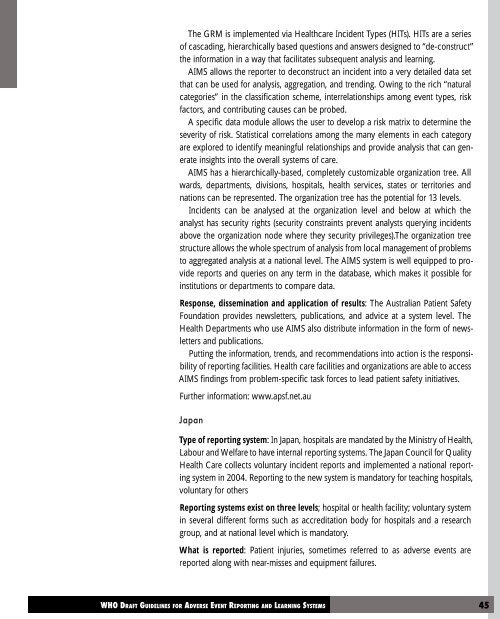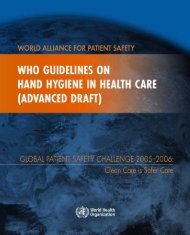Adverse event reporting.pdf
Adverse event reporting.pdf
Adverse event reporting.pdf
Create successful ePaper yourself
Turn your PDF publications into a flip-book with our unique Google optimized e-Paper software.
The GRM is implemented via Healthcare Incident Types (HITs). HITs are a series<br />
of cascading, hierarchically based questions and answers designed to “de-construct”<br />
the information in a way that facilitates subsequent analysis and learning.<br />
AIMS allows the reporter to deconstruct an incident into a very detailed data set<br />
that can be used for analysis, aggregation, and trending. Owing to the rich “natural<br />
categories” in the classification scheme, interrelationships among <strong>event</strong> types, risk<br />
factors, and contributing causes can be probed.<br />
A specific data module allows the user to develop a risk matrix to determine the<br />
severity of risk. Statistical correlations among the many elements in each category<br />
are explored to identify meaningful relationships and provide analysis that can generate<br />
insights into the overall systems of care.<br />
AIMS has a hierarchically-based, completely customizable organization tree. All<br />
wards, departments, divisions, hospitals, health services, states or territories and<br />
nations can be represented. The organization tree has the potential for 13 levels.<br />
Incidents can be analysed at the organization level and below at which the<br />
analyst has security rights (security constraints pr<strong>event</strong> analysts querying incidents<br />
above the organization node where they security privileges).The organization tree<br />
structure allows the whole spectrum of analysis from local management of problems<br />
to aggregated analysis at a national level. The AIMS system is well equipped to provide<br />
reports and queries on any term in the database, which makes it possible for<br />
institutions or departments to compare data.<br />
Response, dissemination and application of results: The Australian Patient Safety<br />
Foundation provides newsletters, publications, and advice at a system level. The<br />
Health Departments who use AIMS also distribute information in the form of newsletters<br />
and publications.<br />
Putting the information, trends, and recommendations into action is the responsibility<br />
of <strong>reporting</strong> facilities. Health care facilities and organizations are able to access<br />
AIMS findings from problem-specific task forces to lead patient safety initiatives.<br />
Further information: www.apsf.net.au<br />
Japan<br />
Type of <strong>reporting</strong> system: In Japan, hospitals are mandated by the Ministry of Health,<br />
Labour and Welfare to have internal <strong>reporting</strong> systems. The Japan Council for Quality<br />
Health Care collects voluntary incident reports and implemented a national <strong>reporting</strong><br />
system in 2004. Reporting to the new system is mandatory for teaching hospitals,<br />
voluntary for others<br />
Reporting systems exist on three levels; hospital or health facility; voluntary system<br />
in several different forms such as accreditation body for hospitals and a research<br />
group, and at national level which is mandatory.<br />
What is reported: Patient injuries, sometimes referred to as adverse <strong>event</strong>s are<br />
reported along with near-misses and equipment failures.
















